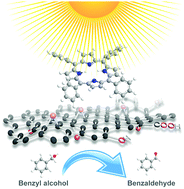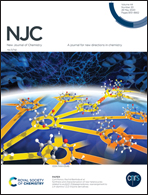Surface modification of graphene oxide via noncovalent functionalization with porphyrins for selective photocatalytic oxidation of alcohols†
Abstract
Modification of graphene oxide (GO) with porphyrins, TPP and ZnTPP (TPP = 5,10,15,20-tetraphenyl-21H,23H-porphine), was achieved by facile synthesis through a self-assembly process. GO–porphyrins composites were characterized by scanning electron microscopy, and UV-visible, fluorescence, photoluminescence and Raman spectroscopy, which confirmed the successful attachment of TPP and ZnTPP onto the GO surface via π–π stacking. The coordination of oxygen functional groups on GO to the Zn center of ZnTPP was also observed. The latter interaction was proposed to account for the lower catalytic activity of the GO–ZnTPP composite compared to that of the GO–TPP one because it hindered the accessible active sites on the GO surface, i.e. epoxy groups. Compared to unmodified GO and pristine porphyrins, the GO–porphyrin composites exhibited remarkable photocatalytic enhancement under irradiation using a light emitting diode. Moreover, the GO–TPP composite was shown to be a competent and reusable photocatalyst for selective alcohol oxidation under mild conditions, affording desired products in moderate to excellent yields.



 Please wait while we load your content...
Please wait while we load your content...